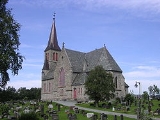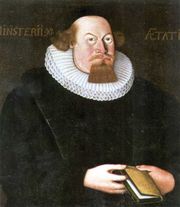
Melhus church
Encyclopedia
Melhus Church also known as "the Gauldal Cathedral", is a large stone church in Melhus
, Norway
. It was built in 1892, after the older (medieval) church building was demolished. The churchyard
contains a cemetery
.
The church contains a controversial oil-painting, which was traditionally thought to be a portrait of Petter Dass
.
(more or less equivalent to a parish), but Melhus kirke was the main one. Two of the five churches were located in Leinstrand
and Flå
; the remaining two churches were in Hølonda
.
In 1889, a Royal Decree
was issued which ordered that the old Melhus kirke be demolished. During this demolition, in 1890, a perfectly preserved hatchet
dating from about 1100 was discovered in a wall of the medieval church. This axe
was identified as the country's only preserved tool for cutting stone (Norwegian: "steinhuggerøks") from that period, and it is presently located in the Norwegian Museum of Science and Technology
.
Although the old church was torn down, several architectural elements of the medieval building were saved and incorporated into the new building. Much woodwork from the old church was included in the newer one. The old portal was also reused in the new church.
Apparently a few artifacts from the old church were not moved to the new church, and instead ended up in other places. When Gerhard Schøning
visited the old medieval church he noticed this: "At the southern side of the entrance to the choir, there is an Epitaph
that Karen and Anders Helkands have erected to their parents and children". When the medieval church was demolished in 1890, the epitaph was no longer there. Few people knew that the epitaph was hidden on Søndre Melhuus farm.
The newer church building has been carefully maintained for over one hundred years; it has had several renovations.
In 1999, Medieval runic
inscriptions were discovered on the medieval portal. These inscriptions were professionally examined in 2001.
 Melhus kirke houses a collection of painted portraits, primarily of clergymen. The most well-known painting is one that has traditionally been considered to be a portrait of Petter Dass
Melhus kirke houses a collection of painted portraits, primarily of clergymen. The most well-known painting is one that has traditionally been considered to be a portrait of Petter Dass
, a 17th-century Norwegian poet and hymn writer. The painting was thought to be the only existing portrait of the poet.
A few years ago, after some nearby churches were set on fire, there was a debate as to whether the portrait was secure enough. Some historians however believe that the subject of this famous portrait is not Petter Dass at all, but the clergy
man Oluf Mentzen Darre. For example, Kåre Hansen is absolutely certain that this portrait has nothing to do with Petter Dass. (Kåre Hansen wrote a book about the poet, his power, and the myths surrounding him. In this book the author analyzed and investigated the painting, and came to the conclusion that the man depicted in this famous portrait is not Petter Dass.)
Subsequently the Petter Dass Museum became involved in the controversy. S. Gustavsen found it strange that the portrait is still shown on the Petter Dass Museum web site, commenting that to consider this painting to be a portrait of Petter Dass is the same as to still "believe that the earth is flat and the sun orbits the earth." The museum itself cannot prove whether the portrait is of Petter Dass or not, and so they feature the debate on their web site. In the meantime the "portrait of Petter Dass" in Melhus church remains, surrounded by myth and mystery.
Melhus
Melhus is a village and municipality in Sør-Trøndelag county, Norway. It is part of the Gauldalen region. The administrative centre of the municipality is the village of Melhus...
, Norway
Norway
Norway , officially the Kingdom of Norway, is a Nordic unitary constitutional monarchy whose territory comprises the western portion of the Scandinavian Peninsula, Jan Mayen, and the Arctic archipelago of Svalbard and Bouvet Island. Norway has a total area of and a population of about 4.9 million...
. It was built in 1892, after the older (medieval) church building was demolished. The churchyard
Churchyard
A churchyard is a patch of land adjoining or surrounding a church which is usually owned by the relevant church or local parish itself. In the Scots language or Northern English language this can also be known as a kirkyard or kirkyaird....
contains a cemetery
Cemetery
A cemetery is a place in which dead bodies and cremated remains are buried. The term "cemetery" implies that the land is specifically designated as a burying ground. Cemeteries in the Western world are where the final ceremonies of death are observed...
.
The church contains a controversial oil-painting, which was traditionally thought to be a portrait of Petter Dass
Petter Dass
Petter Dass was a Lutheran clergyman and the foremost Norwegian poet of his generation, writing both baroque hymns and topographical poetry. -Biography:He was born at Northern Herøy , Nordland, Norway...
.
History
The church stands in a scenic valley. In 1589, there were five churches in Melhus prestegjeldPrestegjeld
A Prestegjeld is a geographic and administrative area of the Church of Norway roughly equivalent to a parish. A prestegjeld can consist of one or many congregations...
(more or less equivalent to a parish), but Melhus kirke was the main one. Two of the five churches were located in Leinstrand
Leinstrand
Leinstrand is a former municipality in Sør-Trøndelag county, Norway. The area of Leinstrand encompasses the south central part of the city of Trondheim. The local Leinstrand Church was built in 1673.-History:...
and Flå
Flå, Sør-Trøndelag
Flå is a former municipality in Sør-Trøndelag county, Norway. Flå is located in the eastern part of the present-day municipality of Melhus. The administrative centre was the village of Ler. The main church for the area is Flå Church.-History:...
; the remaining two churches were in Hølonda
Hølonda
Hølonda is a former municipality in Sør-Trøndelag county, Norway. Hølonda encompasses the southwestern part of the present-day municipality of Melhus, west of the Gaula River. The main church for the area is Hølonda Church.-History:...
.
In 1889, a Royal Decree
Decree
A decree is a rule of law issued by a head of state , according to certain procedures . It has the force of law...
was issued which ordered that the old Melhus kirke be demolished. During this demolition, in 1890, a perfectly preserved hatchet
Hatchet
A hatchet is a single-handed striking tool with a sharp blade used to cut and split wood...
dating from about 1100 was discovered in a wall of the medieval church. This axe
Axe
The axe, or ax, is an implement that has been used for millennia to shape, split and cut wood; to harvest timber; as a weapon; and as a ceremonial or heraldic symbol...
was identified as the country's only preserved tool for cutting stone (Norwegian: "steinhuggerøks") from that period, and it is presently located in the Norwegian Museum of Science and Technology
Norwegian Museum of Science and Technology
The Norwegian Museum of Science and Technology is a science museum located in Oslo, NorwayThe museum as an institution was founded in 1914 as a part of the commemoration for the 100th anniversary of the Norwegian Constitution, but it was not until 1932 that the museum was first opened, in the...
.
Although the old church was torn down, several architectural elements of the medieval building were saved and incorporated into the new building. Much woodwork from the old church was included in the newer one. The old portal was also reused in the new church.
Apparently a few artifacts from the old church were not moved to the new church, and instead ended up in other places. When Gerhard Schøning
Gerhard Schøning
Gerhard Schøning was a Norwegian historian. His Reise som giennem en Deel af Norge i de Aar 1773, 1774, 1775 paa Hans Majestets Kongens Bekostning documenting travel through Trondheim, Gudbrandsdal and Hedmark, Norway in 1773–1775 has been recognized as both a historical reference and as a "minor...
visited the old medieval church he noticed this: "At the southern side of the entrance to the choir, there is an Epitaph
Epitaph
An epitaph is a short text honoring a deceased person, strictly speaking that is inscribed on their tombstone or plaque, but also used figuratively. Some are specified by the dead person beforehand, others chosen by those responsible for the burial...
that Karen and Anders Helkands have erected to their parents and children". When the medieval church was demolished in 1890, the epitaph was no longer there. Few people knew that the epitaph was hidden on Søndre Melhuus farm.
The newer church building has been carefully maintained for over one hundred years; it has had several renovations.
In 1999, Medieval runic
Medieval runes
The medieval runes, or the futhork, was a Scandinavian 27 letter runic alphabet that evolved from the Younger Futhark after the introduction of dotted runes at the end of the Viking Age and it was fully formed in the early 13th century...
inscriptions were discovered on the medieval portal. These inscriptions were professionally examined in 2001.
The "Petter Dass" portrait

Petter Dass
Petter Dass was a Lutheran clergyman and the foremost Norwegian poet of his generation, writing both baroque hymns and topographical poetry. -Biography:He was born at Northern Herøy , Nordland, Norway...
, a 17th-century Norwegian poet and hymn writer. The painting was thought to be the only existing portrait of the poet.
A few years ago, after some nearby churches were set on fire, there was a debate as to whether the portrait was secure enough. Some historians however believe that the subject of this famous portrait is not Petter Dass at all, but the clergy
Clergy
Clergy is the generic term used to describe the formal religious leadership within a given religion. A clergyman, churchman or cleric is a member of the clergy, especially one who is a priest, preacher, pastor, or other religious professional....
man Oluf Mentzen Darre. For example, Kåre Hansen is absolutely certain that this portrait has nothing to do with Petter Dass. (Kåre Hansen wrote a book about the poet, his power, and the myths surrounding him. In this book the author analyzed and investigated the painting, and came to the conclusion that the man depicted in this famous portrait is not Petter Dass.)
Subsequently the Petter Dass Museum became involved in the controversy. S. Gustavsen found it strange that the portrait is still shown on the Petter Dass Museum web site, commenting that to consider this painting to be a portrait of Petter Dass is the same as to still "believe that the earth is flat and the sun orbits the earth." The museum itself cannot prove whether the portrait is of Petter Dass or not, and so they feature the debate on their web site. In the meantime the "portrait of Petter Dass" in Melhus church remains, surrounded by myth and mystery.

